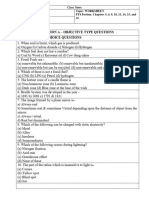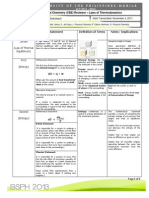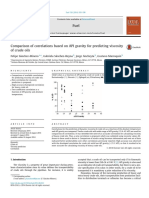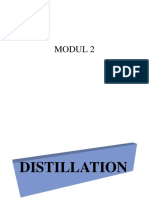0 ratings0% found this document useful (0 votes)
91 viewsChemistry: (Mock Test-1) 41
Chemistry: (Mock Test-1) 41
Uploaded by
hazeThe document contains 80 multiple choice questions related to chemistry. The questions cover topics such as organic chemistry, inorganic chemistry, physical chemistry, and chemical reactions. The questions test knowledge of concepts like chemical bonding, acid-base reactions, oxidation-reduction reactions, and thermodynamics.
Copyright:
© All Rights Reserved
Available Formats
Download as PDF, TXT or read online from Scribd
Chemistry: (Mock Test-1) 41
Chemistry: (Mock Test-1) 41
Uploaded by
haze0 ratings0% found this document useful (0 votes)
91 views5 pagesThe document contains 80 multiple choice questions related to chemistry. The questions cover topics such as organic chemistry, inorganic chemistry, physical chemistry, and chemical reactions. The questions test knowledge of concepts like chemical bonding, acid-base reactions, oxidation-reduction reactions, and thermodynamics.
Original Description:
bitsat
Original Title
2 Chemistry
Copyright
© © All Rights Reserved
Available Formats
PDF, TXT or read online from Scribd
Share this document
Did you find this document useful?
Is this content inappropriate?
The document contains 80 multiple choice questions related to chemistry. The questions cover topics such as organic chemistry, inorganic chemistry, physical chemistry, and chemical reactions. The questions test knowledge of concepts like chemical bonding, acid-base reactions, oxidation-reduction reactions, and thermodynamics.
Copyright:
© All Rights Reserved
Available Formats
Download as PDF, TXT or read online from Scribd
Download as pdf or txt
0 ratings0% found this document useful (0 votes)
91 views5 pagesChemistry: (Mock Test-1) 41
Chemistry: (Mock Test-1) 41
Uploaded by
hazeThe document contains 80 multiple choice questions related to chemistry. The questions cover topics such as organic chemistry, inorganic chemistry, physical chemistry, and chemical reactions. The questions test knowledge of concepts like chemical bonding, acid-base reactions, oxidation-reduction reactions, and thermodynamics.
Copyright:
© All Rights Reserved
Available Formats
Download as PDF, TXT or read online from Scribd
Download as pdf or txt
You are on page 1of 5
CHEMISTRY (Mock Test-1)
41. Which of the following compounds has
the least tendency to form hydrogen
bonds between molecules ? Mock Test–1 (Chemistry)
(a) NH4OH (b) CH3F
(c) NH3 (d) HF
42. The ratio of the difference in energy
between the first and second Bohr orbit
to that between second and third Bohr
atom in H-atom is :
(a) 4/9 (b) 1/3 (c) 27/5 (d) 1/2
43. How many molecules are present in one
gram of hydrogen ?
(a) 3⋅01 × 1023 (b) 1⋅5 × 1023
(c) 2⋅5 × 1023 (d) 6⋅02 × 1023
44. The shape of covalent molecule AX3 is :
(a) T-shape
(b) triangular
(c) pyramidal
(d) Any of the above three depending
upon the number of lone pairs on
A
45. Which of the following molecular orbital
has the lowest energy ?
(a) π∗ 2pz
(b) π∗ 2py
(c) σ 2px
(d) σ∗ 2px
46. The enthalpy of formation for
o
C2H4(g), CO2(g) and H2O(l)at 25 C and
1 atm pressure be 52, -394, -286
kJ mol−1 respectively. The enthalpy of
combustion of C2H4(g) will be :
(a) −141⋅2 kJ mol−1 (b) −1412 kJ mol−1
(c) +141⋅2 kJ mol−1 (d) +1412 kJ mol−1
47. When equal volumes of the following
solutions are mixed, precipitation of
AgCl (Ksp = 1⋅8 × 10−10) will occur only
with :
(a) 10−10 M (Ag+) and 10−10 M (Cl−)
(b) 10−4 M (Ag+) and 10−4 M (Cl−)
(c) 10−5 M (Ag+) and 10−5 M (Cl−)
(d) 10−5 M (Ag+) and 10−6 M (Cl−)
Mock Test–1 (Chemistry)
48. The heats of combustion of C2H4, C2H6
and H2 are−1400⋅5 kJ, −1558⋅3 kJ and
−285⋅6 kJ. The heat of hydrogenation of
ethene is :
(a) 273⋅6 kJ (b) 1⋅368 kJ
(c) –136⋅8 kJ (d) 13⋅68 kJ
49. In which of the following binary
compound, the ratio rcation ⁄ ranion is
least ?
(a) CsF (b) LiF
(c) LiI (d) CsI
50. BF3 is a :
(a) Bronsted acid (b) Bronsted base
(c) Lewis acid (d) Lewis base
51. What is the order of reaction which has
a rate expression
Rate = K [A]3 ⁄ 2 [B]−1 ?
1
(a) (b) 3/2
2
(c) Zero (d) None of these
52. For a reversible process at equilibrium,
the entropy change can be expressed as :
ΔH
(a) ΔS = (b) ΔS = T ΔH
T
qrev
(c) ΔS = (d) Δ = T⋅qrev
T
53. The rate of a reaction :
(a) depends upon temperature
(b) is not equal to its molecularity
(c) is equal to its molecularity
(d) can not be predicted
54. A compound formed by element A and
B crystallises in cubic structure in which
A atoms are at the corners of the cube
while B atoms are in the centre of cube.
Formula of the compound is :
(a) A2B3 (b) AB2
(c) AB3 (d) AB
55. pH of 10−9 M HCl is :
(a) >7 (b) < 7
(c) 7 (d) 8
56. The emf of the cell involving the reaction :
2Ag+(aq) + H2(g) → 2Ag(s) 2H+(aq)
is 0⋅80V. The standard oxidation
potential of silver electrode is :
(a) 0.20 V (b) 0.40 V
(c) –0.80 V (d) 0.80 V
Mock Test–1 (Chemistry)
57. The solution containing 4⋅0 g of PVC in
one litre of dioxane was found to have
osmotic pressure of 6⋅0 × 10−4 atm at
300K. The molecular mass of polymer is :
(a) 5⋅6 × 104 (b) 1⋅6 × 105
(c) 3⋅0 × 10−2 (d) 6⋅4 × 102
58. Calculate the molality of solution
prepared by dissolving 18 g of
glucose (molecular mass= 180) in 500g of
water :
(a) 0.2 M (b) 0.1 M
(c) 0.4 M (d) 1.2 M
59. What would happen when a small
quantity of H2O2 is added to solution of
FeSO4 ?
(a) An electron is added to Fe2+
(b) An electron is lost by Fe2+
(c) Colour disappear
(d) H2 is evolved
60. Which of following method is not
employed for the purification of colloids?
(a) Ultracentrifugation
(b) Peptisation
(c) Dialysis
(d) Electrodialysis
61. If the mass defect of 4X9 is 0⋅09 a.m.u,
then the binding energy per nucleon is :
(a) 8.38 MeV (b) 83⋅8 MeV
(c) 931⋅5 MeV (d) 9⋅315 MeV
62. From the following enthalpies of
combustion, deduce which of the quoted
expressions gives the heat of formation
of CH4 at a fixed temperature.
C + O2(g) → CO2(g) ; ΔH = c
H2(g) + 1 ⁄ 2 O2(g) → H2O(l) ; ΔH = h
CH4(g) + 2O2(g) → CO2(g) + 2H2O(l) ;
ΔH = m :
(a) c + 2h − m (b) −1 ⁄ 2c—h + 1 ⁄ 2m
(c) c + h − m (d) −c − h + m
63. Copper can be extracted from :
(a) kupfer nickel (b) dolomite
(c) malachite (d) galena
Mock Test–1 (Chemistry)
64. The phenomenon of syneresis is :
(a) migration of colloid in an electric field
(b) process of converting gel into a true
solution
(c) separation of the dispersed phase
from the gel
(d) formation of a sol from a gel
65. Which of following members of nitrogen
family does not show negative oxidation
state ?
(a) Bi (b) Sb
(c) As (d) P
66. The freezing poing of heavy water is :
(a) −3⋅82oC (b) −4oC
(c) 3⋅82oC (d) 0oC
67. Plaster of Paris is :
(a) CaSO4⋅H2O (b) 2CaSO4⋅2H2O
(c) CaSO4⋅2H2O (d) CaSO4⋅1 ⁄ 2H2O
68. Composition of Kopper’s gas is :
(a) CO (14−16%) + H2 (35−42%)
+ CO2 (30%) + CH4 (10−15%)
(b) CO (51⋅1%) + CO2 (12⋅6%) + H2 (34%)
+ N2 (1⋅9%) + O2 (0⋅1%) + CH4
(c) CO (46%) + H2(36.6%) + CO2 (14%) +
N2 (1.1%) + CH4(2.4%)
(d) none of the above
69. Which one of the following combines
with Fe(II) ions to form brown complex ?
(a) N2O3 (b) N2O5
(c) N2O (d) NO
70. H2S2O8 is :
(a) Marshall’s acid
(b) a peroxy compound
(c) an intermediate in the manufacture of
H2SO4
(d) (a) and (b) both
71. Liquid oxygen is :
(a) pale yellow (b) dark blue
(c) pale blue (d) colourless
Mock Test–1 (Chemistry)
72. Decomposition of H2O2 is a first order
reaction. A 16 volume solution of H2O2
having half life 15 minutes is present
initially. When will the solution become
‘‘1 volume’’ :
(a) after 120 minutes
(b) after 150 minutes
(c) after 60 minutes
(d) after 90 minutes
73. Lucas reagent is :
(a) Na + H2O
(b) H2SO4 + HCl
(c) MnO2 + H2O
(d) ZnCl2 + HCl (conc.)
74. Potassium is kept in :
(a) ammonia (b) alcohol
(c) kerosene (d) water
75. The correct formula of Borax is :
(a) Na2B4O7⋅8H2O
(b) Na2 [B4O5 (OH)4 ]⋅10H2O
(c) Na2B4O7⋅4H2O
(d) Na2 [B4O5 (OH)4 ]⋅8H2O
76. Which of the following metal is obtained
by the electro-metalluragy ?
(a) Ag (b) Na
(c) Fe (d) Pb
77. Which of the following has highest
ionisation energy ?
(a) Cu (b) Au
(c) Ag
(d) All have equal ionisation energies
78. Chemical reduction is not suitable for :
(a) conversion of bauxite into
aluminium
(b) conversion of cuprite into copper
(c) conversion of haematite into iron
(d) conversion of zinc oxide to zinc
79. Toluene on oxidation with chromyl
chloride produces :
(a) benzaldehyde (b) benzoic acid
(c) chlorobenzene (d) none of these
80. Which of the following is an important
constituent of transistors ?
(a) Osmium (b) Radium
(c) Germanium (d) Silver
You might also like
- Determine Flow Back Volume To SurfaceDocument4 pagesDetermine Flow Back Volume To SurfaceMufti Ghazali100% (4)
- Hydrogen Cooling of Electrical GeneratorsDocument80 pagesHydrogen Cooling of Electrical GeneratorsFahad Khalil86% (7)
- DiagnosticreviewDocument18 pagesDiagnosticreviewapi-248607804No ratings yet
- History of Zero (0)Document7 pagesHistory of Zero (0)Arun K GuptaNo ratings yet
- Rolling Sphere Tool Guide: I. II. IiiDocument14 pagesRolling Sphere Tool Guide: I. II. IiiRashad SarwarNo ratings yet
- Mensuration Questions and Answers: CompetoidDocument4 pagesMensuration Questions and Answers: CompetoidAloma FonsecaNo ratings yet
- Chemistry 151 Final Exam Review QuestionsDocument12 pagesChemistry 151 Final Exam Review Questionsmiketol100% (1)
- Chemistry AminesDocument8 pagesChemistry AminesVanshika LudhaniNo ratings yet
- Chapter 12 Organic Chemistry Some Basic Principles and TechniquesDocument21 pagesChapter 12 Organic Chemistry Some Basic Principles and TechniquesNitish MehraNo ratings yet
- Cbse Class 12 Chemistry Mcqs For BiomoleculesDocument3 pagesCbse Class 12 Chemistry Mcqs For BiomoleculeskarthikNo ratings yet
- WAEC Past Questions and Answers On Physics-MergedDocument15 pagesWAEC Past Questions and Answers On Physics-Mergedlovelyeshun7No ratings yet
- PHYSICS XI CH-7 (System of Particles and Rotational Motion)Document57 pagesPHYSICS XI CH-7 (System of Particles and Rotational Motion)Nandita JainNo ratings yet
- CBSE Class 12 Chem Notes Question Bank Haloalkanes and Haloarenes PDFDocument18 pagesCBSE Class 12 Chem Notes Question Bank Haloalkanes and Haloarenes PDFhehe11No ratings yet
- SS2 CorrectedDocument15 pagesSS2 CorrectedsunliasNo ratings yet
- 8 ScienceDocument7 pages8 ScienceRayrc Pvt LtdNo ratings yet
- 10th ICSE MATHS MATRICESDocument21 pages10th ICSE MATHS MATRICESSANDEEP SINGHNo ratings yet
- Important Questions For CBSE Class 10 Science Chapter 2Document32 pagesImportant Questions For CBSE Class 10 Science Chapter 2Shaurya 5116jNo ratings yet
- Further Maths Examination 2023 Second TermDocument5 pagesFurther Maths Examination 2023 Second Termdavidaceyen2018No ratings yet
- 9 - QP - Amine and Diazonium SaltDocument6 pages9 - QP - Amine and Diazonium Saltpriyanshu dwivediNo ratings yet
- D and F Block Elements 2Document9 pagesD and F Block Elements 2Dr. P.S.SenguptaNo ratings yet
- Test1 Goc & Poc Tough by S.K.sinha See Chemistry Animations atDocument3 pagesTest1 Goc & Poc Tough by S.K.sinha See Chemistry Animations atmyiitchemistry100% (1)
- CHEMISTRYDocument7 pagesCHEMISTRYOkhare PaulNo ratings yet
- SS2 Chemistry (2nd Term)Document7 pagesSS2 Chemistry (2nd Term)kazosky4topNo ratings yet
- FULAFIA MBBS Post UTME Past Questions & Answers (2023 Updated by Schoolcampus - Com.ng)Document27 pagesFULAFIA MBBS Post UTME Past Questions & Answers (2023 Updated by Schoolcampus - Com.ng)isahjibrilkev6No ratings yet
- Question Bank of Haloalkanes and Haloarenes: Very Short Answer Type Questions of One Mark EachDocument3 pagesQuestion Bank of Haloalkanes and Haloarenes: Very Short Answer Type Questions of One Mark EachRahul RajNo ratings yet
- Brilliant Education Centre: Science - PhysicsDocument3 pagesBrilliant Education Centre: Science - Physicsasamad54No ratings yet
- 11th Physics Model Question Paper emDocument3 pages11th Physics Model Question Paper emAjit0% (1)
- Mantra MCQ PDFDocument10 pagesMantra MCQ PDFAnySika0% (1)
- Answer All Questions in This Section, All Question Carry Equal MarksDocument4 pagesAnswer All Questions in This Section, All Question Carry Equal Markssulayajanny100% (1)
- PhysicsDocument5 pagesPhysicsAyo100% (1)
- 2ND Term S2 Mathematics - 2Document51 pages2ND Term S2 Mathematics - 2Adelowo DanielNo ratings yet
- SS 2 Maths Cat 2 3RD TermDocument5 pagesSS 2 Maths Cat 2 3RD Termpraiseforever90No ratings yet
- CH 9 and 10 AP Part 2 AnswersDocument7 pagesCH 9 and 10 AP Part 2 AnswersjohntheuglyllamaNo ratings yet
- Mathematics Assignment For Ss2Document4 pagesMathematics Assignment For Ss2The Tech WhiZNo ratings yet
- Mathematics Second Term ExaminationDocument18 pagesMathematics Second Term ExaminationAbdul Rasaq MukailaNo ratings yet
- Free Waec Past Questions On ChemistryDocument6 pagesFree Waec Past Questions On Chemistrytourayadam419No ratings yet
- HCF LCM In/EnglishDocument14 pagesHCF LCM In/Englishpesmobile TamilNo ratings yet
- Physic Ss2 2019Document4 pagesPhysic Ss2 2019sulayajannyNo ratings yet
- ss2 Chemistry 1st TermDocument5 pagesss2 Chemistry 1st Termadeshinasamuel017No ratings yet
- Alcohols, Phenols, Ethers - Board QuestionsDocument7 pagesAlcohols, Phenols, Ethers - Board QuestionsIron ManNo ratings yet
- SS 2 Physics Practical Question 3RD Term 2020-2021Document4 pagesSS 2 Physics Practical Question 3RD Term 2020-2021praiseforever90No ratings yet
- Physical Chemistry Reviewer - Laws of ThermodynamicsDocument2 pagesPhysical Chemistry Reviewer - Laws of ThermodynamicsJerome SadudaquilNo ratings yet
- Excellence in English Senior Secondary 1 Teachers GuideDocument161 pagesExcellence in English Senior Secondary 1 Teachers GuidedavidtemajagbeNo ratings yet
- SS3 PhysicsDocument2 pagesSS3 PhysicsSUNDAY JAMESNo ratings yet
- HYDROCARBONS Plusone HssliveDocument13 pagesHYDROCARBONS Plusone HssliveAthulRKrishnanNo ratings yet
- Music Note For JS 2 1ST Term Collapsed 2020Document25 pagesMusic Note For JS 2 1ST Term Collapsed 2020Emmanuel Urom EzeNo ratings yet
- Chem PaperDocument4 pagesChem PaperKeertana SN100% (1)
- Ss 2 Civic Education Cat1 2021Document4 pagesSs 2 Civic Education Cat1 2021praiseforever90No ratings yet
- MATHEMATICs SS1Document2 pagesMATHEMATICs SS1Bigshow MaxNo ratings yet
- Page No 345Document43 pagesPage No 345nabil soukNo ratings yet
- Mole ConceptDocument14 pagesMole ConceptBronil, John Angelo J.No ratings yet
- Xii Isc Notes Chapter 3 Solid State2Document27 pagesXii Isc Notes Chapter 3 Solid State2Abhijeet TrivediNo ratings yet
- SS2 Chemistry Ass For The M.T BreakDocument6 pagesSS2 Chemistry Ass For The M.T Breakadedolapodorcas56No ratings yet
- 2Document6 pages2Kuo Garol Sarong100% (1)
- Objective PhysicsDocument4 pagesObjective PhysicsleoyodapieNo ratings yet
- Jss1 Basic ScienceDocument9 pagesJss1 Basic SciencevbestNo ratings yet
- PhysicsDocument2 pagesPhysicsAyotunde OladojaNo ratings yet
- JSS 3 Mathematics Mid Term ExaminationDocument4 pagesJSS 3 Mathematics Mid Term ExaminationochaienoNo ratings yet
- B D B F C A E C: Engineering Problem Solving With C++, 3e Chapter 2 Test BankDocument5 pagesB D B F C A E C: Engineering Problem Solving With C++, 3e Chapter 2 Test BankbashairNo ratings yet
- Physics Exam ss2 2nd TermDocument14 pagesPhysics Exam ss2 2nd TermchrizyboyziNo ratings yet
- Physics Exam Second TermDocument2 pagesPhysics Exam Second Termsunlias100% (1)
- Gravitation: Arride Learning Online E-Learning AcademyDocument25 pagesGravitation: Arride Learning Online E-Learning AcademyOm JethwaniNo ratings yet
- SS 2 Maths 1ST Ca Test First Term 2022Document8 pagesSS 2 Maths 1ST Ca Test First Term 2022Akinola OlalekanNo ratings yet
- BITSAT Practise TestsDocument336 pagesBITSAT Practise Testssiddharth1996No ratings yet
- ETBE Technical SheetDocument28 pagesETBE Technical SheettoanvmpetrologxNo ratings yet
- High Voltage EngineeringDocument36 pagesHigh Voltage EngineeringsukandeNo ratings yet
- Comparison of Correlations Based On API Gravity For Predicting Viscosity of Crude Oils PDFDocument7 pagesComparison of Correlations Based On API Gravity For Predicting Viscosity of Crude Oils PDFDamir986No ratings yet
- Simpo: Addressable Fire Alarm PanelDocument2 pagesSimpo: Addressable Fire Alarm PanelEolo RojasNo ratings yet
- Aerodynamic CirculationDocument6 pagesAerodynamic CirculationChegrani AhmedNo ratings yet
- 10th Physics Book Back 1 Mark Question Paper English Medium PDF DownloadDocument6 pages10th Physics Book Back 1 Mark Question Paper English Medium PDF DownloadEI GODHRANo ratings yet
- Mineral Resources PDFDocument28 pagesMineral Resources PDFannayaNo ratings yet
- Inverter DatasheetDocument3 pagesInverter DatasheetYash GuptaNo ratings yet
- Hyundai Couty DiagramDocument181 pagesHyundai Couty DiagrammanhNo ratings yet
- Saes P 123Document18 pagesSaes P 123HatemS.MashaGbehNo ratings yet
- Bedugul Geothermal Prospect and DevelopmentsDocument12 pagesBedugul Geothermal Prospect and DevelopmentsFikri Adam DermawanNo ratings yet
- (TC31) IEC 60079-0 Edition 6.0 (2011-06-22)Document9 pages(TC31) IEC 60079-0 Edition 6.0 (2011-06-22)Shirish100% (1)
- Operation Manual TruTool N700 (1A1)Document26 pagesOperation Manual TruTool N700 (1A1)Catalin VladNo ratings yet
- Petroleum Origin NeerajDocument8 pagesPetroleum Origin NeerajNeeraj BhusariNo ratings yet
- HP Top Project AwardsDocument9 pagesHP Top Project AwardsSterlingNo ratings yet
- DS GSD GSD V GSF GSF V Electronic Glass Fuses 250V MersenDocument1 pageDS GSD GSD V GSF GSF V Electronic Glass Fuses 250V MersenAdrián T.V.No ratings yet
- VMC Booster Test With SolnsDocument35 pagesVMC Booster Test With Solnsamogh kumar67% (3)
- A Differential Equation Is A Mathematical Equation For An Unknown Function of One or Several Variables That Relates The Values of The Function Itself and Its Derivatives of Various OrdersDocument1 pageA Differential Equation Is A Mathematical Equation For An Unknown Function of One or Several Variables That Relates The Values of The Function Itself and Its Derivatives of Various OrderschrajnaagNo ratings yet
- Ac Ageing Characteristics of Y2O3 Doped ZnO Varistors With High Voltage GradientDocument3 pagesAc Ageing Characteristics of Y2O3 Doped ZnO Varistors With High Voltage GradientJanja TothNo ratings yet
- GFDP 107 52 ELE DS GE 004 DS For Power Transformer, Rev 2 SignedDocument9 pagesGFDP 107 52 ELE DS GE 004 DS For Power Transformer, Rev 2 SignedMr ElEcTrOnNo ratings yet
- Job Specification For Piping Support Design For Topsides: Browse Floating LNG PROJECTDocument47 pagesJob Specification For Piping Support Design For Topsides: Browse Floating LNG PROJECTfarisanNo ratings yet
- Me 04-601Document15 pagesMe 04-601Vishnu DasNo ratings yet
- 2009 10 Otti Solarcooling PalermoDocument6 pages2009 10 Otti Solarcooling PalermoKelvinVelasquezPascualNo ratings yet
- BCR8PM 8Document7 pagesBCR8PM 8Alul ScratchNo ratings yet
- Construction and Building Materials: Tayfun Çiçek, Yasin ÇinçinDocument7 pagesConstruction and Building Materials: Tayfun Çiçek, Yasin ÇinçinInzimam Ul haqNo ratings yet
- Distilation and Flash VaporizationDocument24 pagesDistilation and Flash Vaporizationahmad jamalNo ratings yet

























































































